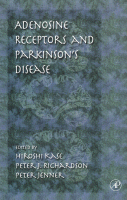Browse content
Table of contents
Actions for selected chapters
- Full text access
- Book chapterAbstract only
Chapter 1 - Introductory Remarks: Adenosine A2A Receptor Antagonists: A Novel Approach to the Treatment of Parkinson's Disease
Hiroshi Kase
Pages 1-15 - Book chapterAbstract only
Chapter 2 - Localization of Adenosine Receptors in Brain and Periphery
Sarah J. Augood, Piers C. Emson and David G. Standaert
Pages 17-30 - Book chapterAbstract only
Chapter 3 - Medicinal Chemistry of Adenosine Receptors in Brain and Periphery
Junichi Shimada and Fumio Suzuki
Pages 31-48 - Book chapterAbstract only
Chapter 4 - Overview of the Physiology and Pharmacology of Adenosine in the Peripheral System
Akira Karasawa
Pages 49-76 - Book chapterAbstract only
Chapter 5 - Biochemical Characterization of Adenosine Agonists and Antagonists
Hiromi Nonaka and Michio Ichimura
Pages 77-i - Book chapterAbstract only
Chapter 6 - Physiology of Adenosine Receptors in the Striatum: Regulation of Striatal Projection Neurons
Akihisa Mori and Tomomi Shindou
Pages 107-127 - Book chapterAbstract only
Chapter 7 - Regulation of Neurotransmitter Release in Basal Ganglia by Adenosine Receptor Agonists and Antagonists in Vitro and in Vivo
Peter J. Richardson and Masako Kurokawa
Pages 129-148 - Book chapterAbstract only
Chapter 8 - Control of Gene Expression in Basal Ganglia by Adenosine Receptors
Alistair K. Dixon and Peter J. Richardson
Pages 149-170 - Book chapterAbstract only
Chapter 9 - Knockout Mice in the Study of Dopaminergic Diseases
Shiro Aoyama, Hiroshi Kase, ... Emiliana Borrelli
Pages 171-191 - Book chapterAbstract only
Chapter 10 - Effects of Adenosine Receptors: Experimental Models of Cognition and Motor Behavior
Shizuo Shiozaki, Shunji Ichikawa, ... Yoshihisa Kuwana
Pages 193-210 - Book chapterAbstract only
Chapter 11 - Actions of Adenosine Antagonists in Primate Model of Parkinson's Disease
Tomoyuki Kanda and Peter Jenner
Pages 211-227 - Book chapterAbstract only
Chapter 12 - Selective Adenosine A2AReceptor Antagonism as an Alternative Therapy for Parkinson's Disease: A Study in Nonhuman Primates
A Hadj Tahar, R. Grondin, ... H. Kase
Pages 229-244 - Book chapterAbstract only
Chapter 13 - Neurobiology of Adenosine Receptors: Adenosine and Its Metabolites in Movement Disorders
Masahiro Nomoto
Pages 245-255 - Book chapterAbstract only
Chapter 14 - The Relevance of Adenosine A2A Antagonists to the Treatment of Parkinson's Disease: Concluding Remarks
Peter Jenner
Pages 257-263 - Book chapterNo access
Index
Pages 265-275
About the book
Description
This book is the first definitive overview on adenosine receptor antagonists and their application to the treatment of Parkinson's Disease. The effect of these novel non-dopamine drugs on vitro and in vivo systems clearly shows their potential for the treatment of this debilitating disease. This book covers how the Parkinson's disease antagonist drug, A2A, has been researched, developed, and tested. It is an essential book for researchers interested in the basal ganglia, purine biology, and Parkinson's Disease.
This book is the first definitive overview on adenosine receptor antagonists and their application to the treatment of Parkinson's Disease. The effect of these novel non-dopamine drugs on vitro and in vivo systems clearly shows their potential for the treatment of this debilitating disease. This book covers how the Parkinson's disease antagonist drug, A2A, has been researched, developed, and tested. It is an essential book for researchers interested in the basal ganglia, purine biology, and Parkinson's Disease.
Key Features
- Discusses the discovery and development of a novel non-dopaminomimetic agent for Parkinson's disease
- Provides the first definitive overview of adenosine antagonists and their role in the treatment of Parkinson's disease
- Presents a new mechanism of action of adenosine A2A receptor antagonists in motor function
Proposes a hypothesis of adenosine A2A receptor function in the striatum - Comprehensive overview of adenosine, its receptor subtypes, their antagonists/agonists from biochemistry, molecular biology, medicinal chemistry, physiology, pharmacology, and neurochemistry viewpoints
- Discusses the discovery and development of a novel non-dopaminomimetic agent for Parkinson's disease
- Provides the first definitive overview of adenosine antagonists and their role in the treatment of Parkinson's disease
- Presents a new mechanism of action of adenosine A2A receptor antagonists in motor function
Proposes a hypothesis of adenosine A2A receptor function in the striatum - Comprehensive overview of adenosine, its receptor subtypes, their antagonists/agonists from biochemistry, molecular biology, medicinal chemistry, physiology, pharmacology, and neurochemistry viewpoints
Details
ISBN
978-0-12-400405-4
Language
English
Published
2000
Copyright
Copyright © 2000 Elsevier Inc. All rights reserved
Imprint
Academic Press
